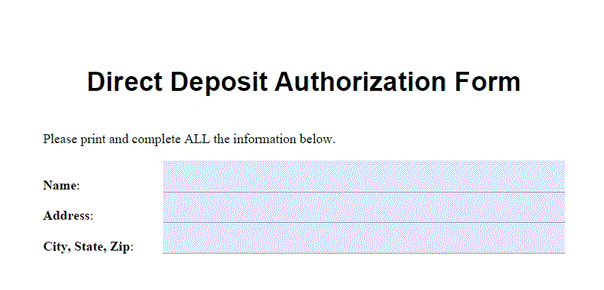What is a Direct Deposit?
Direct Deposit Form is an electronic transfer service that allows employers, government departments, or other organizations to make electronic deposits directly into an account holder’s bank account. This does away with the check-writing process with the efficiency of direct deposit, making the transaction faster, safer, and more reliable.
Application:
Salary and wages
Tax Refunds
Social Security
Retirement account and pension payments
Vendor and supplier payments
Since the funds are taken out of the checker’s account, they can cash or deposit it without going to a bank.
How Does Direct Deposit Work?
Direct deposit is based on a secure fund transmission system called the Automated Clearing House (ACH) network. Here’s how it generally works:
Authorization: Authorization is sought by the payer, normally an employer, who requests direct deposit from their account into the payee’s bank account.
Bank Information: The payee receives bank information related to the bank account number, routing number, and type of account.
Payment Processing: The payer transmits the payment instructions through the ACH network.
Deposit: The recipient’s bank accepts the funds and posts them to the payee’s account.
However, processing times vary, this typically takes 1-2 working days to complete.
Advantages of Direct Deposit
Direct deposit has various advantages for the payers and receivers, making it one of the best forms of electronic payment.
To Employees/Recipients:
Convenience: they don’t need to go to a bank to deposit their checks
Speed: the money is available in
seconds after the processing period.
Security: lesser chances of losing the checks or getting stolen
Budgeting: one will be able to know the amount and time that they will receive the pay without delay.
Green: It saves paper, thus mitigating the effect on the environment.
To the Employer/Payee:
Cost Savings: No printing, mailing, or handling of paper checks.
Increases Efficiency: It saves payroll time and resources.
Enhanced Security: It reduces fraud and unauthorized cashing checks.
Employee Satisfaction: Payment within time leads to an improved moral outlook from the employee’s end
What is a Direct Deposit Form & How do I Fill it out?
The direct deposit form is one of the documents that, after filling out, the payer can process the electronic transfers. It gathers banking details and also gets the authorization of the recipient. Here’s how you fill up a direct deposit form:
Basic Information: Your full name, address, phone number, and other contact details must be written.
Banking Details: Pledge your bank account type (checking or savings), routing number, and account number.
Deposit Distribution: If necessary, you can also specify how you would like your deposit split among several accounts.
Authorization: Sign the form to allow the payer to initiate direct deposits.
Attach a Voided Check: Some employers or payers may insist on a voided check to confirm banking information.
The direct deposit form usually comes from the employer, government agency, or financial institution.
Types of Direct Deposit
Under any of the following circumstances, direct deposit may be utilized:
Payroll Direct Deposit: Payroll Direct Deposit is mainly used by employers to remit salary expenses.
Government Benefits: Social Security and unemployment benefits, as well as any payment that the government owes to a single person, are made through this facility.
Tax Refunds: The government directly deposits tax refunds in taxpayers’ bank accounts.
Vendor Payments: Businesses directly pay the suppliers.
Expense Reimbursement: A company directly reimburses expenses to employees’ bank accounts.
Is Direct Deposit Safe?
Direct deposit is generally pretty secure. It uses the ACH network, is covered under federal laws and is regularly monitored for suspicious transactions. There are also a few other safety measures.
Encryption: The bank account data and the actual payment instructions are encrypted.
Verification: Both employers and financial institutions need to verify your identities.
Alerts: Many banks will send alerts when you have a direct deposit.
How to Get Started with Direct Deposit
You don’t have to do much of anything to set up direct deposit:
Get a Direct Deposit Form: You can get this from your employer, government agency, or a financial institution.
Fill the form with your bank routing and account numbers, etc.
Submit the form to your payer or employer.
Wait for confirmation: Setting up the direct deposit may take one to two pay cycles.
How long does a direct deposit take?
Usually, the processing time for direct deposit transactions can vary between 1-2 business days, depending on the bank’s turnaround times and a particular bank’s practices. Funds often become available immediately or on the following business day.
Frequent Problems with Direct Deposit
Although direct deposit is very secure, sometimes things may go wrong:
Incorrect Bank Account Information: The wrong account number or routing number can guarantee that funds will not be deposited into the account.
Bank Delays: Some banks are slow in processing and, therefore, cause delays in the deposit
Authorization Problems: In certain cases, deposits are impossible if the authorization form is handled incorrectly.
Conclusion
Direct deposit is easy and secure to use when managing financial transactions. It is simple for both the employer and the employee and a safer and more convenient alternative to traditional checks. Maximizing this electronic payment method will depend on knowing how direct deposit works, its benefits, and how to fill out a direct deposit form.
Frequently Asked Questions
What Is Direct Deposit?
Direct deposit is the electronic payment system that sends the funds directly into your bank account, bypassing paper checks.
How Do I Fill Out a Direct Deposit Form?
Complete the form with your name, the type of bank account you have, the routing and account numbers. Sign the form and attach a voided check if necessary.
Is Direct Deposit Safe?
Yes, safe. The ACH network encrypts and verifies with strict identity to ensure secure transactions.
How many days does a direct deposit take?
It is typically 1-2 business days, depending on the payers’ processing times and the recipient’s bank.
Can I Split My Direct Deposit into Multiple Accounts?
Yes, most employers allow you to divide your direct deposit into multiple accounts, such as checking and savings accounts.
Why Haven’t I Received My Direct Deposit?
Some typical offenders for late or missing direct deposit include providing bank information, delays by the bank, and errors on authorization forms.
Can I Have Social Security Benefits Paid Directly into My Bank Account?
You can. Benefits from Social Security can be deposited straight into your bank account. To enrol in the direct deposit program, simply provide your banking information to the Social Security Administration.
Do I Have to Pay a Fee to Establish Direct Deposit?
Most banks and employers do not charge for sending direct deposits. However, always check with your bank.
Direct deposit best practices benefit businesses and individuals by improving their payment methods and financial handling.



